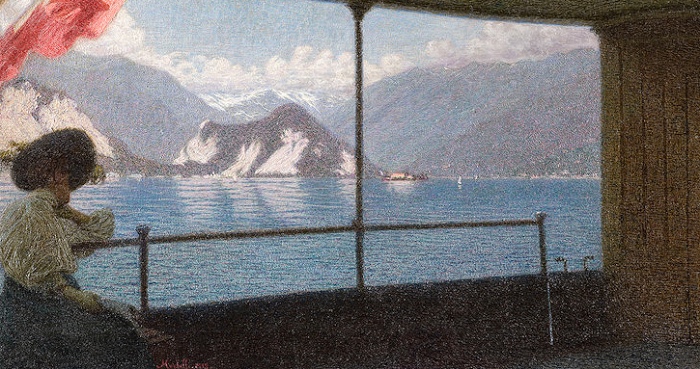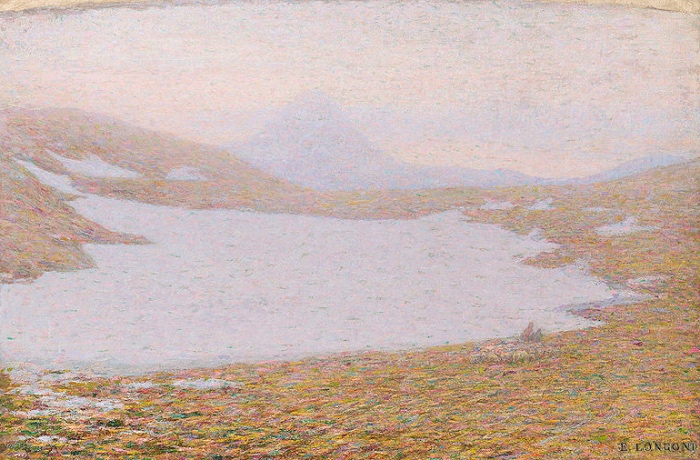
Giovanni Segantini
DIVISIONISM: THE ORIGIN OF MODERN PAINTING IN ITALY
Divisionism. Divisionism manifested itself in 1891 at the Triennale di Brera with the first public exhibition of a group of young artists: Giovanni Seganti, Giuseppe Pellizza de Volpedo, Angelo Morbelli, and Emilio Longoni.
What those artists showed upset and divided art critics and public, not only because they used a new painting technique consisting of juxtaposition of colour spots applied on the canvas, but also because they gave an innovative interpretation of social subjects and nature.

Morbelli Angelo
Divisionism is similar to French Pointillism, of which George Seurat is the main proponent (looks at his works in the post I wrote about the artist).
Both of these artistic movements appeared in art scene when Impressionism had already exhausted, although it continued to influence generations of artists.
Those painters used not only the basics of Impressionism, but also the colour theory studied by the chemist Chevreul starting from 1840, who noticed how juxtaposition of two colours seemed a unique colour if you looked at it from afar.
READ ALSO: the post I dedicated to Impressionism with the description of this revolutionary artistic movement, but also the post about Post-Impressionism to understand what happened after the crisis of Impressionism.
It was Vittore Grubicy de Dragon who first spread in Italy the techniques and success of Pointillist painters. These techniques were used by Italian artists who would become members of Divisionism.
Italian Divisionists shared with French movement only the use of pure colours, divided rather than mixed, and applied directly on the canvas with small paintbrushes, and only the ability of eye and mind of the viewer could put them back together in order to recreate a unique image.
Unlike Pointillism, which applied the technique as the ultimate aim of the message of the painting, Divisionism used the technique as a way to express the message of the painting, which examined the reality and inserted symbolist elements, as well.
READ ALSO: the post in which I explained what Symbolist is.
Therefore, Divisionists are not disciples of Pointillism, but they created an autonomous artistic movement, and shared with it only technical and theoretical fundamentals.
Divisionism focus on the representation of light and nature, but these paintings don’t represent only mere landscape, but inner landscape which allow ample space also to social themes, in which social differences emerge.

Longoni Emilio


Articolo che capita a fagiolo! Sono stato proprio la settimana scorsa a Milano a vedere la mostra su Boccioni a palazzo Reale e in seguito al Museo del 900. Lì ho trovato diversi riferimenti al Divisionismo (che non conoscevo) e difatti volevo informarmi maggiormente su questa corrente che in effetti mi ricordava parecchio i “puntinisti”. Per le opere che ho visto mi pare piuttosto corretta la descrizione che ne date, soprattutto sulle differenze di tematica e “fine” rispetto al puntinismo.
Comunque sto iniziando a seguire un po’ questo blog e mi piace parecchio!
Grazie Zabriskie per aver iniziato a seguirmi.
Il Divisionismo è un movimento totalmente autonomo dal Pointillisme e anche nella mostra di Rovereto si sottolinea questo aspetto, fondamentale anche per capire perché molti artisti dal Divisionismo passano al Futurismo.
La mostra di Boccioni in realtà si sposterà in autunno a Rovereto ed è la prosecuzione della mostra attualmente in corso . Si tratta di un progetto che il Mart sta portando avanti e che ovviamente si ricollega alla Casa Futurista di Depero, che si trova proprio a Rovereto.
Alla mostra di Boccioni avevo dedicato una mini guida che puoi scaricare gratuitamente qui : http://www.theartpostblog.com/archivio-guide/
A luglio invece, gli iscritti alla newsletter riceveranno la mini guida proprio alla mostra di Rovereto e che sto preparando in collaborazione con il Mart 😉
Ottimo il modo di informare in modo succinto ed al tempo stesso esauriente il lettore su molte problematiche artistiche ed interpretative.
Grazie, credo che sul web si possa scrivere e discutere d’arte con lo scopo di suscitare domande e far nascere il desiderio di approfondire. Ci sono saggi e libri e manuali che descrivono nel dettaglio il Divisionismo, il mio contributo vorrebbe far germogliare il seme della curiosità.